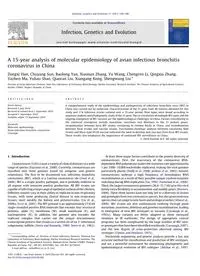
2011 A 15-year analysis of molecular epidemiology of avian infectious bronchitis coronavirus in China PDF
Preview 2011 A 15-year analysis of molecular epidemiology of avian infectious bronchitis coronavirus in China
A 15-year analysis of molecular epidemiology of avian infectious bronchitis coronavirus in China Zongxi Han, Chuyang Sun, Baolong Yan, Xiaonan Zhang, Yu Wang, Chengren Li, Qingxia Zhang, Yazhen Ma, Yuhao Shao, Qiaoran Liu, Xiangang Kong, Shengwang Liu * Division of Avian Infectious Diseases, State Key Laboratory of Veterinary Biotechnology, Harbin Veterinary Research Institute, The Chinese Academy of Agricultural Sciences, Harbin 150001, People’s Republic of China 1. Introduction Coronaviruses (CoVs) cause a variety of clinical diseases in a wide range of species (Enjuanes et al., 2000). Currently, coronaviruses are classified into three genuses based on antigenic and genetic relatedness. The first to be discovered was infectious bronchitis coronavirus (IBV), which is a Gamma coronavirus (de Groot et al., 2008). IBV is a major poultry pathogen, and is probably endemic in all regions with intensive poultry production. All IBV strains are capableofinfecting alargerangeofepithelial surfaces ofthechicken. Different isolates vary in their ability to replicate in non-respiratory tissues, with some producing clinical disease in non-respiratory tissues, most notably the kidney and proventriculus (Liu et al., 2006a; Yu et al., 2001). The IBV genome is an approximately 27.6-kb single-stranded positive RNA molecule that encodes four structural proteins, spike (S), membrane (M), small membrane (E), and nucleoprotein (N). In addition, the genome also encodes the replicase complex that carries out the unique discontinuous transcription process that results in a nested set of six 30 coterminal subgenomic mRNAs (Stern and Kennedy, 1980; Stern et al., 1982). At least three major factors contribute to the genetic diversity of coronaviruses. First, the inaccuracy of the coronavirus RNA- dependent RNA polymerase makesthe mutation rate approximately 1 per 1000–10,000 nucleotides replicated, making the viral genome particularly plastic (Duffy et al., 2008; Jenkins et al., 2002). Second, coronaviruses undergo a high frequency of homologous RNA recombination as a result of their possible unique random template switching during RNA replication (Lai, 1992; Pasternak et al., 2006). Third, the largest coronavirus genomes (26.4–31.7 kb) give this viral family extra flexibility to accommodate and modify genes (Masters, 2006). These three factors have not only led to a diversity of strains and genotypes fromone coronavirusspecies, butalsogeneratednew species that can adaptto new hosts and ecological niches (Woo et al., 2006). IBV strains are also continuously evolving through point mutations, insertions, deletions and genome recombination, leading to emergence of new IBV serotypes or variants (Cavanagh et al., 1992a). Many variants are better adapted or show increased virulence in IB outbreaks. The design of appropriate control programs has been complicated by the large number of IBV sero- or genotypes that have been identified worldwide (Cavanagh, 2007), and the low degree of cross-protection observed among IBV serotypes (Cowen and Hitchner, 1975). Nucleotide sequencing and genetic analysis provide a fast and accurate method for classification and prediction of IBV serotypes, and are a powerful instrument for monitoring phylogenetic and epidemiological evolution of IBV subtypes (Adzhar et al., 1997; Infection, Genetics and Evolution 11 (2011) 190–200 A R T I C L E I N F O Article history: Received 5 July 2010 Received in revised form 1 September 2010 Accepted 1 September 2010 Available online 15 September 2010 Keywords: Molecular epidemiology Avian infectious bronchitis coronavirus Genotype A B S T R A C T A comprehensive study of the epidemiology and pathogenicity of infectious bronchitis virus (IBV) in China was carried out by molecular characterization of the S1 gene from 46 isolates obtained for this study and 174 reference strains isolated over a 15-year period. Nine types were found according to sequence analysis and phylogenetic study of the S1 gene. The co-circulation of multiple IBV types and the ongoing emergence of IBV variants are the epidemiological challenges in China. Factors contributing to the continual emergence include mutations, insertions and deletions in the S1 protein genes; recombination between local IBV strains circulating in chicken flocks in China; and recombination between local strains and vaccine strains. Vaccination-challenge analysis between circulating field strains and Mass-type H120 vaccine indicated the need to develop new vaccines from local IBV strains. These results also emphasize the importance of continued IBV surveillance in China. � 2010 Elsevier B.V. All rights reserved. * Corresponding author at: Division of Avian Infectious Diseases, National Key Laboratory of Veterinary Biotechnology, Harbin Veterinary Research Institute, The Chinese Academy of Agricultural Sciences, Maduan Street, Harbin 150001, People’s Republic of China. Tel.: +86 451 85935065; fax: +86 451 82734181. E-mail address:
